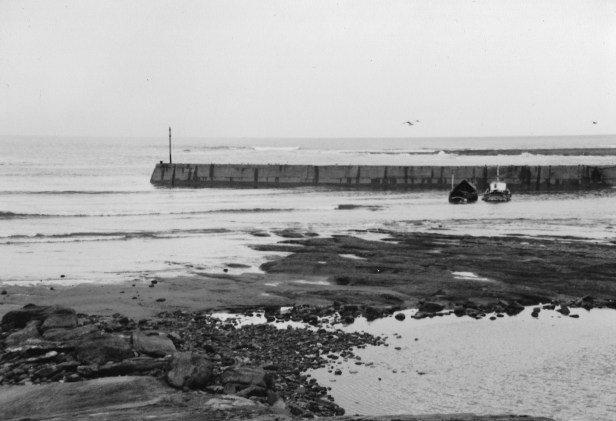
A visitor to Loftus cemetery would likely not notice there is a gap at the junction of Rows B and 35 in the southern section of graves area ‘G’. There is no marker or gravestone. Even if one had been erected, there was no name for the mason to inscribe. No date of birth. No date of death. Within the plot is buried the remains of a man whose body washed ashore at the North Yorks fishing village of Staithes on the morning of August 28th, 1969. Who he was, and how his naked body came to be in the sea that morning, is still a mystery 50 years later.
A Grisly Find
It was my Great Uncle, James Hansell, then 69, who found the body when he went to check his trat (fishing) lines embedded in the rocky shoreline to the North of Staithes harbour. At first, he thought the lines might have snagged a porpoise or small whale in the ebbing tide, but closer he was shocked to see it was the body of a man. Naked, except for a black boot and sock on the left foot, the body looked huge, possibly distended from time in the water. Post-mortem details later released by the Police gave the man’s height as 5ft 11 ½ inches, and weight as 15 stone. The only other descriptions Police offered were heavy-set, clean-shaven, ‘round-faced’, and balding on top with brown hair to the sides and the back of the head. (I have been unable to locate any evidence of a Police photo-fit illustration in the available media coverage).
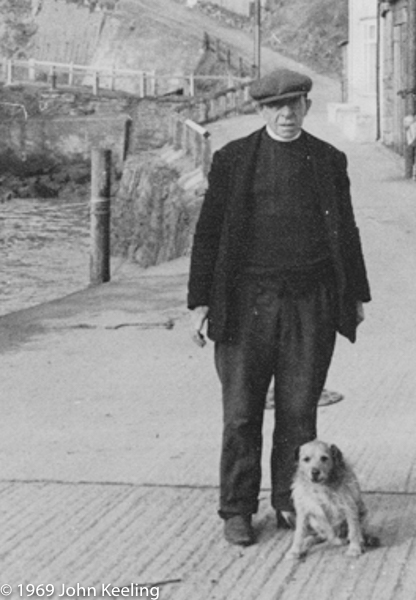
Local schoolboy Michael Stephenson had been walking under the cliffs with his grandfather Ted Shippey when he saw Hansell waving in the distance.[i] As Michael ran towards him, Hansell shouted a warning not to come any closer. But it was too late. Although Stephenson would go to sea in his adult life, and witness recovered corpses, the sight of the body that morning would give him the worst nightmare of his life: one in which the ebbing tide gave the face-down figure a ghastly animation. Hansell, who had to stay with the body lest it be swept out to sea again, asked Stephenson to ‘fetch the police’ and the 10-year old ran back to the village and up its trademark steep bank until he saw a school friend who gave him a lift on his bicycle to the police station house. PC Charlton was not there but his wife made Stephenson a cup of tea until her husband returned and alerted senior officers at Guisborough.
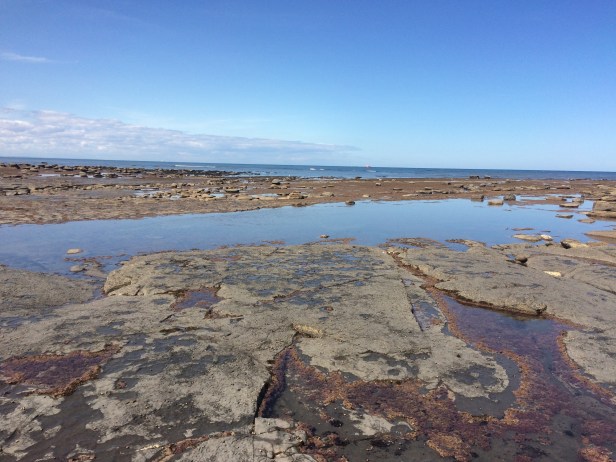
Body Removed
According to a press account, the body was retrieved by four fishermen who carried it back to the beckside. Michael Stephenson believes the fishermen were Matt Verrill (senior and junior), Leonard Cole and George Harrison – the first three crewed the coble The Golden Crown, and Harrison owned Embrace. Because of major works on the big pier at the time, a portable hut had been erected near the old lifeboat station and it is here that Stephenson believes the body was temporarily stored until the arrival of police. It may be that the body was removed to the tiny Victorian mortuary on Saltburn seafront 9 miles to the north.
Initial press accounts of the gruesome find were slender. Police, who had ‘cordoned off a stretch of beach at Cowbar’ commented:
“There has been no person in the area reported missing recently. We are making inquiries to try to find the man’s identity.”
In the following days, press reported the body, believed to have ‘been in the water for several days’, was estimated to be of a man 40-50 years of age, and that Guisborough police were ‘particularly interested to examine any clothing washed ashore on beaches in the area.’ Said a spokesman:
“There has been a fairly wide-spread search to discover the man’s identity, but we have had no success so far. Staithes fishermen believe the tide may have brought the body down from somewhere to the north.”
The inquest on the body was adjourned until September 24th.

A Lonely Burial
Whilst police continued their inquiries, the body was buried on Sept 5th in an unmarked grave at Loftus cemetery, four miles from where it was discovered. Officiating at the ceremony was Rector George Simpson, and apart from the gravediggers the only other person present was Coroner Bernard Wilkinson. The brief committal prayers must have been a dismal event, not even graced by the name of the deceased. The parish records simply acknowledge:
‘6960 (Burial Number) Unidentified Male Person Found dead on foreshore at Sandy Wyke, Cowbar, Staithes. Date of Burial 5 September. Grave No: G-C-35’
It is surely a meagre record of anyone’s life and death.
A month later, The Evening Gazette reported that a nationwide check on missing persons and fingerprints ‘has yielded no clues,’ and checks on shipping in the area had not revealed any crew members reported lost at the relevant time. A senior police spokesman at Guisborough, said:
“We have checked from one of the country to the other, but despite all our inquiries we are really no nearer now to identifying him than we were a month ago.”
The only new information added was that Police believed the man may have been English because he was wearing a type of boot ‘which is not very widely exported.’ The inquest was adjourned until October 22nd while inquiries continued, but they did not bear fruit.
The Coroner’s Findings
At the eventual inquest, Chief Inspector Peter Wilfrid Earnshaw told the coroner that the Police had failed to establish the man’s identity, and attempts to match hair samples with the hair of a man missing from Rochdale for some time had had negative results. Earnshaw said,
‘a thorough search had been made for missing persons and through local and national newspaper, radio and television, and widespread publicity had been given to the circumstances in which the body was found.’
Pathologist Dr Richard E. Petts said the injuries on the body were consistent with having fallen from a height.
“It is my opinion that he fell from a cliff and sustained these injuries when hitting rocks, either on the surface or under the water.”
Certainly, the area in which the body was found is barely a mile from Boulby, which at 666ft is the tallest sea cliff in England. (The injuries referred to were never detailed in media accounts, however, I know from my Uncle, Jim Hansell, that the body had ‘a large hole’, as he described it, around the crown area of the forehead.) Whether the body would have remained in the Boulby area or not, subject to strong tides for a week or more is a moot point.
The coroner’s verdict was: ‘that it was an unidentified male body found at Cowbar, having died from a fracture of the neck with terminal drowning, and that there was not sufficient evidence to say how the body came to be in the sea.’ [Emphasis added].
In other words, in addition to accident or suicide, the man could have been pushed or thrown to his doom. But there the matter lay for another half-century, until I decided to research the story further – simply because I could recall my Uncle Jim finding the body (I was on holiday in Staithes at the time of the incident) – and it always struck me rather mysterious that a dead body could effectively be erased from history. Indeed, it is as if this man had never existed. This was hardly the stone age; Neil Armstrong had walked on the Moon just six weeks before, and Britain had flown a passenger jet capable of twice the speed of sound.
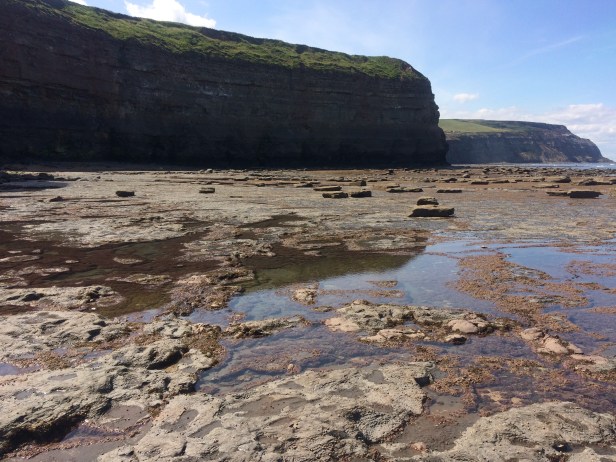
Missing Evidence
I began researching the story in 2017 and immediately ran into the problem of dealing with two sets of authorities, as the incident occurred on the border between North Yorkshire and Cleveland. Which police force or other authority would hold the records? In fact, each police force claimed it held no records and suggested that the other force might. Teesside records were at least able to confirm the burial details (given above).
Clearly, one of the most important avenues of research would be the record of the coroners’ inquest and the pathologist’s report. However, Teesside Coroners office was unable to find any records of the inquest in its archives. I complained to Teesside Archives about this matter and was advised in an email of 9 Oct 2017 from Archives Manager Ruth Hobbins:
‘I can confirm that the above records have not survived. By law they have to be retained for 15 years and should then come to the archives for permanent preservation which is what happens now. We only received few files [sic] when the office in Guisborough closed in 1997…there is a gap between 1940-1986 where no records have survived.’ [Emphasis added]
I was genuinely shocked to hear that vital coroners’ records spanning 46 years were missing and wrote to Ruth Hobbins: ‘it requires little imagination – with regards to this specific 1969 incident – to ascertain the value of such archives to Police cold case investigations, now possible because of DNA databases and other forensic advancements.’
Hobbins replied:
‘I do agree with you and the Police make use of them on a regular basis. They were also important to the families of deceased coal miners a few years ago as they were able to claim compensation from the government as a result of the evidence they contained. It is very unfortunate that they [the records] have been lost and probably as a consequence of the actions of either an individual or due to changes to local government reorganisation.’
The case for Exhumation
The incident begs so many questions. Why was the man practically naked? Whilst his body had likely been in the water for a week, was that sufficient time for body swelling to tear practically all the clothes from his body? How far might tides have carried the body in the un-seasonally cold august days leading up to the discovery? Without any investigative files or records available, they are rhetorical questions.
I know nothing about the man whom my Uncle found on that lonely stretch of shore, in the shadow of the cliffs, in 1969. The wider world has forgotten he ever existed, or even that he was found. He may have been a criminal for all anyone knows. He may have been a foreigner. Or he may have been a victim. But can it be right that he has been erased from history through apparent bureaucratic failures? He doesn’t even appear on the National Crime Agency’s UK Missing Persons Unit list – more than 1,000 cases dating back to the 1950s.
It is perfectly conceivable that some of his contemporaries, possible offspring or other family members still survive (even a potential assailant or murderer). Is this man not owed his identity?
He has left us some evidence in his remains: his DNA. Such forensic investigation was not available to the authorities in 1969. It is now. For his sake, and in the public interest, there is a compelling argument that his remains be exhumed for DNA profiling and potential matching with all available databases. I have suggested this course of action to the appropriate MP’s, Government departments and Police authorities, and will update on their responses.
All press quotes from Evening Gazette (Middlesbrough) and Whitby Gazette.
UPDATE: Many thanks to Naomi Corrigan for picking up this story at TeessideLive.
If you have any information or recollections about the incident, please contact me at jk@johnkeelingmedia.com
[i] At some point, Jim Hansell’s grim and lonely vigil with the body ended when he was joined fellow beachcomber and retired fisherman, John Theaker (72) of Beckside, Staithes. In all likelihood, the two men were distantly related.
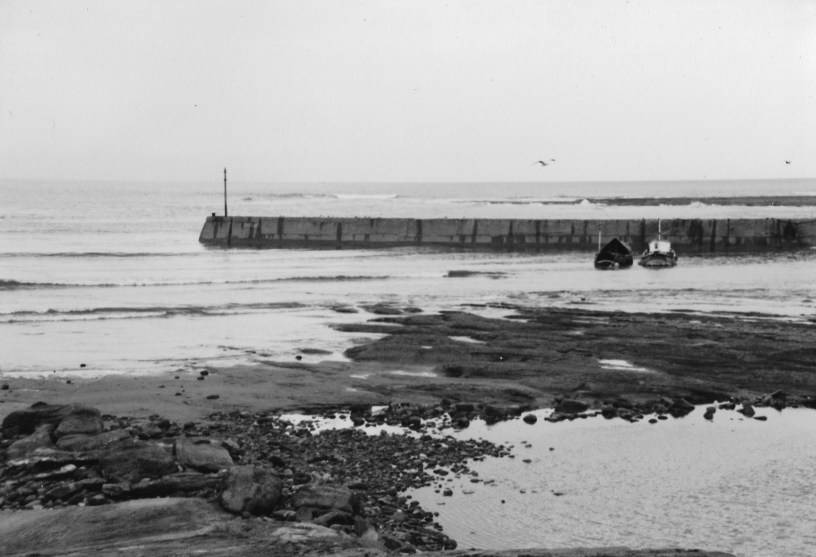
Excellent item, very well written. Staithes is one of my favourite places and we visit as often as we can, but I have never heard of this story. I look forward to any updates.
LikeLike
Many thanks for commenting.
LikeLiked by 1 person
Interesting story. We did a ghost walk at Robin Hood’s Bay recently and these local stories are fascinating. Hopefully DNA testing will be granted.
LikeLike
Thanks for commenting.
LikeLike
An exhumation would also provide another opportunity. A clay impression of the man’s skull could be used to create an impression of his face and, adding the details of his physical appearance that you listed in your piece, a pretty good rendering of how the man would have looked in life could be made, one which would probably be more accurate than any hypothetical 1969 identikit image.
LikeLike